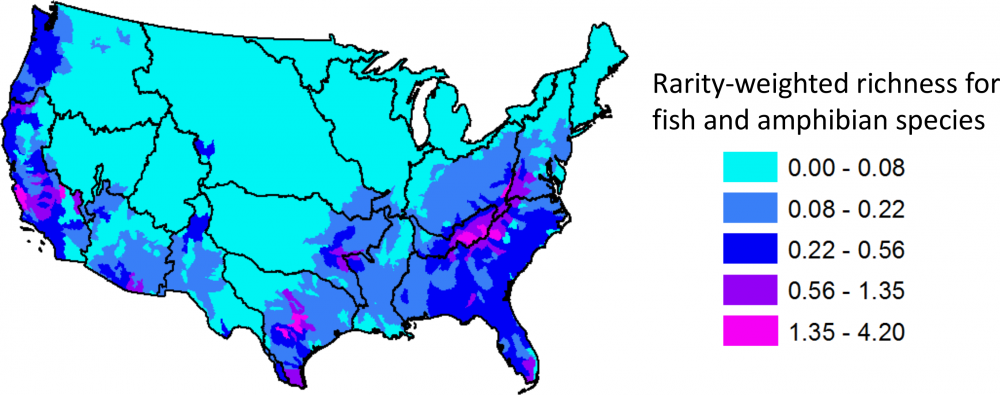Posted 03/10/14
Freshwater ecosystems, such as lakes, streams, wetlands and rivers, provide resources and habitat for aquatic and terrestrial organisms, but they are sensitive to land use and land cover change. Sebastian Martinuzzi, a post-doc at SILVIS, used future land-use scenarios to quantify the impact of future land use change on freshwater ecosystems in the US. Regions with high levels of freshwater biodiversity are likely to see increased levels of threats, but changes in conservation policies may help to alleviate future threats in some regions.
Freshwater ecosystems throughout the U.S. harbor a variety of life, from single-celled organisms to large reptiles and fish. They also supply invaluable resources for people, such as drinking water, and in some cases electricity. Yet, both the use of the water systems and the land surrounding them can hamper their ability to meet the needs of the biota that depend on them. Human use of aquatic ecosystems can lead to overfishing, introduction of invasive species, and altered hydrology. Various systems are threatened or endangered by land use and land cover change within the watershed, resulting in degraded water quality via pollution and runoff. Nutrient pollution can harm species that live in the water, and at the very least, degrade the health of those who consume it. Thus, it is important to assess future threats to water quality instigated by land use.Sebastian has researched future land use in the U.S. under different scenarios. It is, of course, impossible to know what will really happen in the future, but it is possible to make educated guesses. For example, Sebastian has investigated hypothetical scenarios of future land use such as business as usual, urban containment, and high crop demand, across the conterminous U.S. Business as usual means projections following recent trends, urban containment reflects the implementation of smart growth policies limiting urban sprawl, and high crop demand reflects increase in crop commodity prices. Sebastian focused on changes in cropland and urban areas, since prior research has shown that >30-50% agricultural, and >10-20% urban land cover within a watershed is sufficient to produce a significant decline in water quality. Sebastian has also assessed freshwater ecosystem biodiversity using a weighted-rarity richness index, focusing on fish and amphibians.

The study, published recently in the journal Global Change Biology, showed that the highest biodiversity freshwater ecosystems, located generally in the southeastern U.S. and parts of the West, are projected to experience the highest rates of urbanization. Areas of already-high water quality stress are also likely to experience increased urban development. This means there is a probable threat to water quality in those regions. However, agricultural land cover is expected to decrease in some regions, which may provide some opportunities for mitigation. The scenarios showed also that limiting urban sprawl could reduce future urban pressure in some watersheds, and that increase in agricultural demands could increase crop cover expansion in areas of high biodiversity.

Using these findings, it is possible to plan for ways to protect watersheds in these sensitive areas. Sebastian’s projections may be used by land planners in order to prioritize acquisitions that would protect the watersheds we depend on. Knowing that, for example, a certain area is prone to building pressures, agencies might want to take the opportunities to acquire land that could reduce impacts on water quality. Projecting and monitoring impacts on vital resources will be crucial to the way we plan for, and manage, both human and ecological systems in the future.”
Story by Radeloff, Volker
